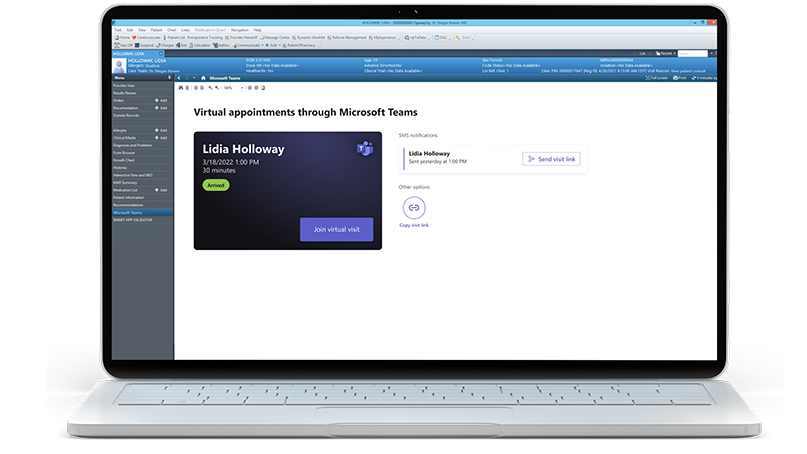Over the last two years, the pandemic has created enormous pressure on the nation's healthcare system. It has also placed a considerable burden on a shorthanded healthcare workforce. Unfortunately, many don't see a light at the end of the tunnel. A recent Microsoft Workforce Trend Index special report found that 57 percent of healthcare frontline workers worldwide are concerned that stress at work will stay the same or worsen in the year ahead.
Healthcare organizations are overwhelmed and concerned with how best to deal with these challenges. The encouraging news is that technology can help. Becker's Hospital Review recently spoke with Tulsi Keshkamat, head of product for frontline at Microsoft, and David Newman, principal program manager lead at Microsoft, about how digital tools can empower frontline healthcare workers and improve their work environment.
Frontline employees need help throughout the patient journey
The tidal wave of patients with COVID-19 has put the greatest pressure on healthcare workers responsible for hands-on care. In response, technology companies like Microsoft are deploying tools to streamline processes and reduce the administrative burden healthcare providers experience every day.
Unnecessary workflow steps can create stress for employees. Friction exists in all aspects of patient care from scheduling appointments to conveying urgent information quickly. Thoughtfully designed digital solutions can simplify these tasks.
"Technology makes it easy to get the right information to the right people at the right time," Ms. Keshkamat said. "Microsoft Teams, for example, centralizes secure communications on a platform that supports text, images, audio and video, as well as priority notifications and targeted communications by role. The Walkie Talkie features in Teams keep critical, time-sensitive communications one-click away."
According to the Work Trends Index special report, the monthly use of Microsoft Teams on the front lines in healthcare grew 560 percent between March 2020 and November 2021. In addition, over half of healthcare frontline workers (57 percent) indicated that they are excited about the job opportunities that technology creates.
Virtual appointments improve access and safety, but the employee learning curve can be steep
Virtual appointments are now commonplace in healthcare. For many providers, however, deploying and learning new systems to support this care modality has been more stressful than necessary.
A smooth transition to remote patient care requires a long-term virtual health and remote collaboration strategy. This must include technology tools that span the entire lifecycle of a virtual appointment.
The virtual appointment functionality in Microsoft Teams offers frictionless scheduling across departments, as well as self-scheduling options for patients. In addition, organizations can digitize the patient intake process with Microsoft Forms.
"To provide the best experience, Teams virtual appointments offer an online waiting room for patients which providers can customize with their own branding and welcome message," Mr. Newman said. "We know that people are often on the go, so it's possible to join Teams virtual appointment using mobile devices. To reduce technical issues, patients can also complete a test call ahead of time. This maximizes the amount time that people can spend with providers."

Virtual appointments with Teams are designed for compliance with healthcare security requirements like HIPAA and HITRUST. Integrating virtual appointments into existing clinical workflows is simple, now that the Microsoft Teams EHR connector is generally available for organizations using Epic, and for Cerner customers. Thanks to this integration, health systems can schedule and launch virtual appointments directly from the EHR.
The virtual appointment queue enables staff to monitor and manage patient flow. The dashboard displays all appointments for the day, as well as real-time status updates. When a patient joins the online waiting room, the status changes and the waiting time is displayed. The dashboard shows missed virtual appointments, wait times and other metrics that can help practices improve their productivity.

Leaders must deploy tools that help employees focus on what matters
Keys to reducing the administrative burden of healthcare workers include eliminating manual tasks, automating workflows and increasing flexibility. Microsoft Shifts, for example, simplifies schedule management and coordination for frontline workers. Employees can use self-service tools integrated with existing workforce management systems to swap shifts, track time, and take ownership of their schedules.
Frictionless information sharing also keeps employees on the same page. With Microsoft Stream, it's possible to share recorded meetings across the organization, while Yammer — Microsoft's social network for businesses — is designed to improve employee engagement and supports an inclusive workplace.
"One way to create greater clarity for workers is to publish tasks in Microsoft Teams," Ms. Keshkamat said. "These might be related to training on new COVID-19 guidelines or care-related follow-ups to ensure continuity. Research has shown that checklists have a tremendous impact on improving healthcare outcomes. Tasks in Teams puts checklist functionality at the fingertips of both managers and care teams."
As healthcare organizations evaluate different technology solutions, Mr. Newman and Ms. Keshkamat recommended leaders keep in mind four ideas:
- Focus on what matters. Help your workforce provide the best possible care by spending less time on manual tasks and schedule conflicts.
- Embrace your mission. Empower employees with tools that align with the organization's goals, while reducing burnout and increasing flexibility.
- Provide the right knowledge. Improve care coordination and the patient experience by simplifying employee onboarding and information sharing.
- Invest in technology platforms, not apps. Platforms enable organizations to centralize collaboration across the organization, customize based on evolving needs and integrate with existing clinical workflows.
Mitigating the workflow difficulties faced by healthcare workers requires an emphasis on immediate priorities, as well as a longer-term view. As Mr. Newman noted, "Reimagining the next healthcare era will take continued agility to respond quickly and to predict what's next. That requires a new focus on the healthcare workforce. Leaders must learn how to build on a strong digital foundation that will carry their organization well into the future."
To learn more about how to empower frontline workers to provide the best possible care, visit Microsoft's website.
Epic is a registered trademark of Epic Systems Corporation.
